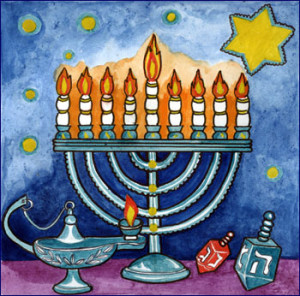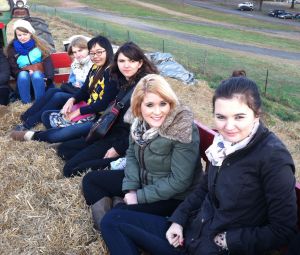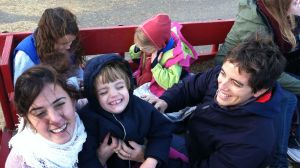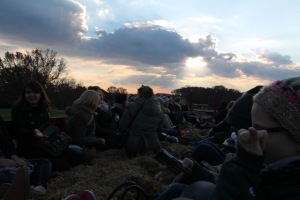Category Archives: Uncategorized
Happy Thanksgiving!!
 THANKSGIVING falls on the fourth Thursday of November. It is as a legal holiday in the United States and commemorates the feast held at Plymouth in 1621 by the Pilgrim colonists and members of the Wampanoag people. The feast was held to honor God and give him thanks for harvest and health.
THANKSGIVING falls on the fourth Thursday of November. It is as a legal holiday in the United States and commemorates the feast held at Plymouth in 1621 by the Pilgrim colonists and members of the Wampanoag people. The feast was held to honor God and give him thanks for harvest and health.
Thanksgiving has religious and cultural origins but is also celebrated in a secular fashion.
The most common dishes on a Thanksgiving table are: TURKEY, sweet potato casserole, collard greens, squash, cornbread stuffing, cranberry sauce and in New Orleans – shrimp and grits.
During a traditional ceremony at the White House, the president of the United States “pardons the turkey” which means the bird can spend the rest of its days back on the farm rather than on a Thanksgiving table.
The day after Thanksgiving, on BLACK FRIDAY people rush to the stores to buy highly discounted merchandise. Black Friday is considered the beginning of the Christmas shopping season.
Thanksgiving Fun For Kids
Here are some activities you can do with the children to celebrate Thanksgiving. Click here to find crafts, coloring sheets, spelling worksheets, math puzzles, nametags and more.
Chanukkah Begins November 27 at Sundown
 We have host families from a wide variety of backgrounds and faiths. Some celebrate Christmas, some Chanukkah, some Kwanzaa and some celebrate more than one of those or none of the above. That is something that makes America special, we can all be different, but still one united together.
We have host families from a wide variety of backgrounds and faiths. Some celebrate Christmas, some Chanukkah, some Kwanzaa and some celebrate more than one of those or none of the above. That is something that makes America special, we can all be different, but still one united together.
I wanted to give a brief overview of Chanukkah and some of the customs you might observe. Something important to note is that Chanukkah is not the Jewish equivalent of Christmas. From a religious standpoint, it is a relatively minor holiday. So, the amount of emphasis put on Chanukkah and how it is celebrated will vary from one family to the next.
You may see Chanukkah spelled in a variety of ways: Chanuka, Hanukkah, Hanukka and more. Part of the reason for this confusion may be due to the fact there is no exact English translation of the Hebrew word for Chanukkah.
If your host family celebrates Chanukkah and you don’t, I would encourage you to take part and experience the customs of another religion. This can be a great opportunity for culture sharing. The same is true, if you are a host family and your au pair celebrates a different holiday than you.
Here is a simple explanation from Judaism 101:
Chanukkah is the festival of lights, commemorating the rededication of the Temple in Jerusalem after a successful revolt against the Seleucid Greeks. As part of the rededication, the victorious Jews needed to light the Temple’s menorah (candelabrum), but they had only enough oil to last one day and it would take eight days to prepare more oil. Miraculously, the one-day supply of oil lasted for eight days. The miracle of the oil is commemorated with this eight-day candle lighting holiday.
Chanukkah begins between Thanksgiving and Christmas. About half of the time, it overlaps with Christmas, but there are many years when Chanukkah ends long before Christmas. In 2002, for example, Chanukkah began on Thanksgiving and ended in the first week of December, but that is unusual.
Almost all Jews light candles with their families for at least some nights of the holiday, so people like to be at home during this holiday. Although almost nobody takes off from work or school for this holiday, many may not want to work nights or travel during the holiday so they can light candles with the family, and accommodations should be made for this.
Here are some links for more info and children’s activities:
Hayride At Linvilla




Daylight Savings Time Ends This Weekend

Daylight Saving Time
During DST, clocks are turned forward an hour, effectively moving an hour of daylight from the morning to the evening. Today, approximately 70 countries worldwide utilize Daylight Saving Time in at least some portion of the country. If you don’t come from one of those countries, I am guessing that the idea may seem strange.
Spring Forward, Fall Back
Most of the United States begins Daylight Saving Time at 2:00 a.m. on the second Sunday in March and reverts to standard time on the first Sunday in November. In the U.S., each time zone switches at a different time.
What do I do?
Enjoy an extra hour of sleep. In the fall, we get back the hour that we lost in the spring. Although, the official change occurs at 2 am, you can turn your clock back one hour before you go to bed on Saturday night.
A Safety Reminder
Many fire departments encourage people to change the batteries in their smoke detectors when they change their clocks because Daylight Saving Time provides a convenient reminder. “A working smoke detector more than doubles a person’s chances of surviving a home fire,” says William McNabb of the Troy Fire Department in Michigan. More than 90 percent of homes in the United States have smoke detectors, but one-third are estimated to have dead or missing batteries.
Information from webexhibits.org
Education matters

We are very proud of the ongoing training we offer our au pairs which provides further educational guidance on a wide range of topics. Our orientation trainers take great care to research and prepare the topics presented via Webinars to our au pairs once placed in the home of a host family. Here is the list of what we have coming up:
October 15
8 pm Nutrition. Good eating for you and your kids
9 pm It’s Up to You. Making the most of your Au Pair year
10 pm Activities to do with Preschoolers
October 29
11 am Language Development: Birth and beyond
12 noon Tantrums are no fun for anyone. Help, my kids are fighting again!
1 pm American holidays: what they are, activities and getting through the holiday blues
November 11
8 pm Managing play with more than one child
9 pm Repatriation
10 pm Feeling Sad or Stressed: Tips for gaining balance in your life
November 26
11 am Help! My kids are fighting again
12 noon Activities for School Age Kids
1 pm Homesickness. Making it through
December 5
8 pm Activities to do with Preschoolers
December 6
9 pm Successfully communicating with your host family
December 9
10 am Homework: Finding the right strategy for your child
December 15
9 pm Homesickness. Making it through
10 pm Toilet Training 101
December 17
8 pm Tantrums are no fun for anyone
TOP TEN ACTIVITIES FOR FALL
Summer is over, and in many places the air is turning colder. As the weather changes be sure to take advantage of what the fall season has to offer. Even if you don’t live in a place that sees a lot colorful leaves, there are fun family-friendly ways to get outdoors this fall:
• Go apple picking. Sure, most of us can get apples year-round from the grocery store, but there’s nothing quite like orchard fresh apples, picked straight from the tree during harvest season. That crunchy, tangy, sweet apple flavor is at its peak during this time of year. Many commercial orchards will let you pick your own. It’s not only fun, it’s also a great way to show kids where their food comes from. Get extras for canning applesauce, or making pies. When you’re done, warm up with a delicious mulled cider.
• Go on a nature hike. Bring along a field guide to identify different kinds of trees. Look for wildlife collecting food for winter. Explain to kids how animals are starting to fatten up and grow thick, protective winter coats. Watch for migrating birds.
• Collect fall leaves. Press them into books or preserve them in glycerin (recipe below*). Paste them onto handmade paper to create greeting cards, or glue them between two pieces of wax paper to make an attractive sun catcher. Go lightly on the glue, or substitute crayon shavings to add color; use a warm iron to melt the shavings and hold the paper together.
• Take a hayride. Many farms offer hayrides during the fall. This is a great way to kick back and enjoy nature with smaller kids who may not be up for a long walk.
• Visit the pumpkin patch. Don’t buy your Halloween pumpkin from the grocery store. Go straight to the source. Kids will love wandering around the patch to pick out the perfect pumpkin. Choose a couple of big ones for jack-o-lanterns, and grab a few smaller ones for painting or general household decorations. Smaller pumpkins make great additions to fall centerpieces. Roast the seeds in your oven with a sprinkling of tasty spices, and grab a few to make pumpkin pies.
• Visit a corn maze. Many farms earn extra income for the winter by turning their cornfields into large mazes. Test your directional sense, and get some fresh air in the process. Corn mazes are fun or all ages.
• Stuff a scarecrow. Dig out an old shirt and overalls, and stuff it with leaves until firm. Add a pumpkin head (from your trip to the pumpkin patch) and you’ve got a great fall decoration.
• Fly a kite. The gusty, brisk air makes autumn a great time for flying kites. Buy one from the store, or make your own from two long sticks, strong paper, and string.
• Have a bonfire. Invite some friends over for a backyard bonfire. The chill in the air makes fall the perfect time to sit together by the warmth of a blazing fire with a nice warm mug of cocoa or cider. Be sure to get any necessary permits from your town first.
• Make a leaf pile and jump in!
Hints for Success – Homesickness/Culture Shock
 Almost everyone experiences culture shock when they come to a completely new environment. Everything is different: the language, the food, and the people.
Almost everyone experiences culture shock when they come to a completely new environment. Everything is different: the language, the food, and the people.
Here are my Top 5 Tips for
Dealing with Homesickness
1. Make Friends – Don’t wait for other au pairs to reach out to you, reach out to them. There are other lots of new au pairs who are feeling the same way you are right now. Set a goal to reach out to a few of them each day. Some will respond and some will not. Don’t let that discourage you. No one will ever be mad at you for sending them a message to say hello or ask if they want to do something together. Make friends from various countries and you will also get a chance to practice your English skills together.
2. Stay in touch with your home country, but not too much. Skyping or talking on the phone every day with your family and/or friends back home normally makes homesickness worse. Try emailing instead and reduce the Skype and phone calls to once a week, until you feel stronger. It’s much harder seeing the faces and hearing the voices of those you miss.
3. Get out of the house (or your room specifically) – Go to cluster meetings, have coffee or movies with other au pairs, join a gym, go to the library, go for a walk, visit the mall, get a manicure, visit a museum. If someone invites you out, say “yes.” Also, don’t be afraid to do the inviting. If your host family invites you to do things with them, say “yes.” This will help you get to know each other and contribute to your overall happiness.
4. Realize that it definitely gets better – All au pairs experience homesickness and nearly all of them stay and have a successful year (some stay for two years.) So, it must get better, right? Once you get past the initial homesickness, most au pairs report how quickly the year goes by.
5. Make Plans – Create your own Au Pair Bucket List (places you want to go, new foods to try, new things to experience during your year in the U.S.) and start doing them now. Post on our cluster Facebook group to find others who may want to join you on your adventures.
UCLA American Studies Course
A class for au pairs and Educare companions who want to master a university level class and take home a certificate from a major U.S. university.
Registration is now open for “American Studies,” offered online through the University of California Los Angeles (UCLA).
Your host family pays the tuition of $500. You receive a reading assignment each week, and you have one or two assignments to do online. Some assignments will test your creative thinking. Some assignments will send you to the internet to do some independent research.
Note that a Global Awareness presentation, volunteer work in the community, and participating in local events are all part of this class (and you will earn 6 credits by completing both the online and community requirements). Ambitious? Yes – most definitely.
If you are curious about the events that have shaped culture and history in the U.S., if you would like a taste of the part women have played in U.S. history, if you want to get involved in the community where you live, if you are mentally adventurous – this is the class for you!
Read more about the class HERE.
The next course runs from September 23, 2013 – February 3, 2014.
Register today at www.uclaextension.edu/aupairs.
Fourth of July – Philadelphia Area Firworks



http://www.narberthpa.com/2013_events/2013_4th_of_July.html#lev01
Radnor High School Fireworks: http://www.radnorscholarshipfund.com
http://www.visitphilly.com/events/philadelphia/july-4th-festival-concert-and-fireworks/
HAVE FUN AND STAY SAFE!!



